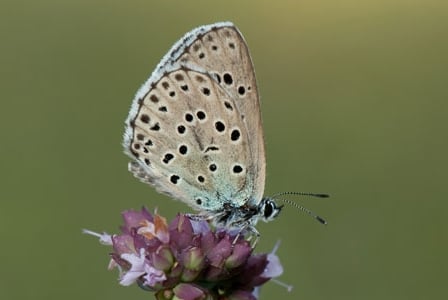
This Wildlife Wednesday, learn about the globally endangered species large blue butterfly and its peculiar relationship a type of ant.
This Wildlife Wednesday, learn about the globally endangered species large blue butterfly and its peculiar relationship with a certain type of ant.
Habitat: throughout Europe, with the exception of the extreme north and south
Large Blue Butterfly trivia
- The large blue depends on two other species for its survival: wild thyme (which it lays its eggs on and its caterpillars eat) and a particular type of red ant called Myrmica sabuleti. This ant finds the caterpillar after it moults (or sheds its outer layer) and eats a liquid secreted by the caterpillar. Then (prepare yourself for what comes next, because it only gets weirder), the caterpillar inflates the skin behind its head so it looks like an ant grub, so the ant takes it home and places it in its own nest. This was all meant to be a trick, of course, and the caterpillar eats the ant grubs (as many as 500 of them!) and takes over the ant’s nest for hibernating. Finally, in June, it emerges as a butterfly. True story.
- Butterflies are seen as very sensitive indicators of the condition of the environment—when their habitat changes, they quickly move on. Scientists can use them to judge the health of the environment.
- The large blue’s two scientific names are Maculinea arion and Phengaris arion.
- It’s blue with a black outer margin, but greyish on the underwing with blue colouring near the base, with spots.
Why they’re threatened
Because the wild thyme and the red ant it depends on require extensive grassland, the large blue butterfly too requires grassland as its habitat. Therefore, the destruction of grassland puts the large blue in danger. It was actually declared extinct in Britain in 1979 but has since been reintroduced with much success.
And it’s not just the large blue—European butterflies in general are under threat, with 10 percent currently at risk of extinction. Much of this is tied to grassland habitat loss.
What you can do
- Learn what you can do to help preserve biodiversity.
- Discover things you can do to help the earth and fight habitat loss.

